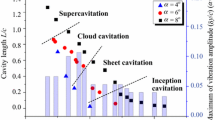Abstract
This paper presents measurements of the speed of sound in two-phase flows characterized by high void fraction. The main objective of the work is the characterization of wave propagation in cavitating flows. The experimental determination of the speed of sound is derived from measurements performed with three pressure transducers, while the void fraction is obtained from analysis of a signal obtained with an optical probe. Experiments are first conducted in air/water mixtures, for a void fraction varying in the range 0–11%, in order to discuss and validate the methods of measurement and analysis. These results are compared to existing theoretical models, and a nice agreement is obtained. Then, the methods are applied to various cavitating flows. The evolution of the speed of sound according to the void fraction α is determined for α varying in the range 0–55%. In this second configuration, the effect of the Mach number is included in the spectral analysis of the pressure transducers’ signals, in order to take into account the possible high flow compressibility. The experimental data are compared to existing theoretical models, and the results are then discussed.























Similar content being viewed by others
References
Abom M, Boden H (1988) Error analysis of two microphones measurements in ducts with flow. J Am Acoust Soc 2429–2438
Arndt REA, Song CCS, Kjeldsen M, He J, Keller A (2000) Instability of partial cavitation: a numerical/experimental approach. In: Proceedings of 23rd symposium on naval hydrodynamics, Val de Reuil, France
Bolpaire S (2000) Etude des écoulements instationnaires dans une pompe en régime de démarrage ou en régime établi. PhD Dissertation ENSAM, July 2000
Brennen CE (2005) Fundamentals of multiphase flows. Cambridge University Press
Costigan G, Whalley PB (1997) Measurements of the speed of sound in air-water flows. Chem Eng J 66:131–135
Coutier-Delgosha O, Reboud JL, Delannoy Y (2003) Numerical simulation of unsteady cavitating flow. Int J Numer Methods Fluids 42(5):527–548
Delannoy Y, Kueny J-L (1990) Two-phase flow approach in unsteady cavitation modelling. Cavitation and multiphase flow forum, ASME-FED vol 98, pp 153–158
Gabillet C, Colin C, Fabre J (2002) Experimental study of bubble injection in a turbulent boundary layer. Int J Multiph Flow 28:553–578
Gouse SW, Brown GA (1964) A survey of the velocity of sound in two-phase mixtures. ASME Paper 64-WA/FE-35
Henry RE, Grolmes MA, Fauske HK (1971) Pressure pulse propagation in two-phase one- and two-component mixtures. Argonne National Laboratory, Rep. 7792
Jakobsen JK (1964) On the mechanism of head breakdown in cavitating inducers. J Basic Eng Trans ASME 291–305
Leroux J-B, Coutier-Delgosha O, Astolfi J-A (2005) A joint experimental and numerical analysis of mechanisms associated to unsteady partial cavitation. Phys Fluids 17(5), paper 052101
Margolis DL, Brown FT (1976) Measurement of the propagation of long-wavelength disturbances trough turbulent flow in tubes. J Fluids Eng 70–78
Merkle CL, Feng J, Buelow PEO (1998) Computational modelling of the dynamics of sheet cavitation. In: Michel J-M, Kato H (eds) Proceedings of 3rd International Symposium on Cavitation, vol 2, pp 307–314
Miles JH (1981) Acoustic transmission matrix of a variable area duct or nozzle carrying a compressible subsonic flow. J Acoust Soc Am 69(6):1577–1586
Nguyen DL, Winter ERF, Greiner M (1981) Sonic velocity in two-phase systems. Int J Multiph Flow 7:311–320
Stutz B, Reboud J-L (1997) Experiment on unsteady cavitation. Exp Fluids 22:191–198
Stutz B, Reboud J-L (2000) Measurements within unsteady cavitation. Exp Fluids 29:545–552
Testud P, Moussou P, Hirschberg A, Aurégan Y (2007) Noise generated by cavitating single-hole and multi-hole orifices in a water pipe. J Fluids Struct 23:163–189
Wallis GB (1969) One-dimensional two-phase flow. McGraw-Hill
Wylie EB, Streeter VL (1978) Fluid transients. McGraw-Hill, New York
Acknowledgments
The authors are very grateful to EDF and CETIM for their financial support of the present work, in the frame of French Industry Research Consortium for Turbomachinery (CIRT). They also express their gratitude to the technical staff of Arts et Metiers ParisTech, especially J. Choquet and P. Olivier, for their assistance.
Author information
Authors and Affiliations
Corresponding author
Electronic supplementary material
Below is the link to the electronic supplementary material.
Rights and permissions
About this article
Cite this article
Shamsborhan, H., Coutier-Delgosha, O., Caignaert, G. et al. Experimental determination of the speed of sound in cavitating flows. Exp Fluids 49, 1359–1373 (2010). https://doi.org/10.1007/s00348-010-0880-6
Received:
Revised:
Accepted:
Published:
Issue Date:
DOI: https://doi.org/10.1007/s00348-010-0880-6



